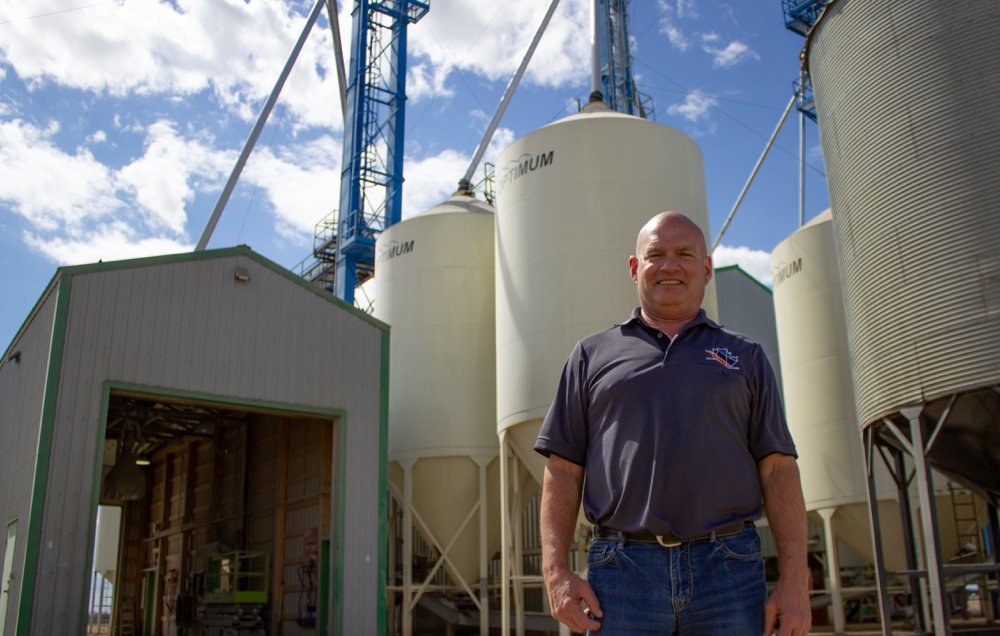Prairie pulse processing still in next-year country
- Posted:
- Category:
- PIC in the News
But that could change as ‘supercluster’ hands out first $40 million to spur processing on the Prairies

Chris Chivilo was nearly ready to break ground on a brand new pulse fractioning plant in Bowden when the bottom fell out of the market.

“Two and a half years ago, we got very close, and then the pulse market went to hell,” said Chivilo, president of W.A. Grain and Pulse Solutions.
“So we put things on hold because of a lack of capital after 18 months of horrible markets. But we’re having a half-decent year this year, so we’re looking at it again, especially with all the work going on in the protein supercluster.”
Pulse processing on the Prairies has been the ‘will they or won’t they?’ story of the past decade for growers of peas, lentils, beans, and chickpeas.
But despite increasing consumer demand for these plant-based proteins and relatively strong growth in pulse acres across Western Canada (pulse acres doubled in Alberta between 2008 and 2017) investment in domestic processing has not kept pace.
Momentum seemed to be picking up toward the end of 2017, when France plant-protein giant Roquette, which has annual sales of $5 billion, began construction on a $400-million pea-processing plant in Portage la Prairie, Man. Shortly after, Academy Award-winning director James Cameron announced another multimillion-dollar processing plant in Vanscoy, Sask. The Vanscoy plant, Verdient Foods, came online last year, while Roquette has pushed its expected opening date to 2020.
But the drive to increase pulse-processing capacity in Canada has slowed since then, and today, few of the rumblings about new pulse fractioning plants in the Prairie provinces have come to fruition.

“There have been investments made in Saskatchewan and in Manitoba, and we’ve had a lot of interest from companies that are seeking to make investments in other provinces as well,” said Bill Greuel, chief executive officer of Protein Industries Canada.
His organization is one of five ‘superclusters’ that Ottawa is bankrolling in hopes of fostering new economic engines in
the decades to come. Protein Industries Canada has been given $150 million and expects that money will leverage another $400 million in industry investment.
“But this is a very long-term game,” said Greuel. “Some of the facilities that are being constructed are in the hundreds of millions of dollars — these are large investments, and they will take time.”
The slowdown in momentum could also be a result of a shift in acres, he added.
“With the export of pulses to India right now and the tariffs that its government has placed on Canadian imports, farmers have probably slowed their production,” said Greuel. “That’s one of the risk factors that companies are considering when they’re making large investments in processing.”
Call for proposals
But for smaller operators like Chivilo, it all comes down to money.
“We’re a small company compared to the other ones that are investing in processing,” he said. “The Canadian pulse companies that still exist are capital strapped because we don’t have the deep pockets of the big guys.”
As a result, Chivilo has had to scale back his plans for the Bowden plant. Initially set to open last year, the new plant was expected to process up to 60,000 tonnes of lentils and peas a year and would include a lentil and pea splitting line and flour mill, dry fractioning line, and wet fractioning line.
Now, the proposed plant will process between 10,000 to 15,000 tonnes of peas and fababeans as a startup volume when it opens (hopefully within the next two years), with the capacity to double that volume in time.
Chivilo has also made his process more efficient. After conducting experiments at the Leduc Food Processing Development Centre last summer, Chivilo scrapped the typical wet and dry fractioning processes he had planned to use in favour of something that would work better in his system.
Now, he’s “taking up the torch again,” re-engineering his plans and working with equipment suppliers to ensure they can duplicate the process on a larger scale. And he’s hoping the protein supercluster will help with that.
“The protein supercluster has spurred us,” said Chivilo. “The investment from Protein Industries Canada has been a big driver in getting back in the saddle to do this now that we’ve gone through the worst of times.”
Last month, Protein Industries Canada announced its first call for proposals, allocating $40 million in co-investment funding for private sector Canadian companies working with plant-based proteins.
“We made this funding available to help new investments in science and innovation so that we can create new products and find new uses for old products,” said Greuel. “Any private sector company in Canada that works in the value-added processing sector or the agriculture sector that wants to do work related to the growth of the plant protein sector is eligible to apply.”
There are a few other eligibility criteria, however. Protein Industries Canada will match investment dollars by up to 50 per cent, with the remainder coming from the private sector. All applicants must be for-profit Canadian businesses that have partnered with other private sector companies to improve collaboration.
Expressions of interest for this first round of funding are due on June 28, with a second call for proposals planned for Sept. 1. (More details can be found at proteinindustriescanada.ca.)
“There’s a lot of potential that we can unlock if we can get pulse processing on the Prairies and really take advantage of the raw commodities we’re producing,” said Greuel, adding Canada produces about 12 million tonnes of plant-based protein a year.
“If you look at the growth in global demand, we can’t satisfy that in Canada. There’s a huge opportunity for us on the Prairies.
“Honestly, the sky’s the limit for plant-based proteins.”
Chivilo agrees.
“Even when all of the fractioning plants get going full speed, there’s still going to be protein shortages,” he said.
“The demand for plant protein has really been understated. The money is available. The hype is out there. The time is now.”
Written by Jennifer Blair
Published by Alberta Farmer Express
